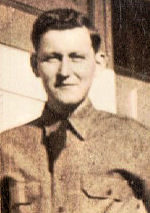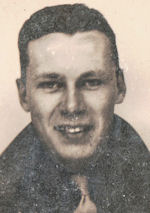Submissions of 303rd Bomb Group related stories and articles are most welcome.



September 18, 2011
Volume III, Issue 9
www.303rdBG.com

Pilot Frederick Gano — Tail Gunner Ed Nelson
September 28, 1944
by
L. E. Rogers
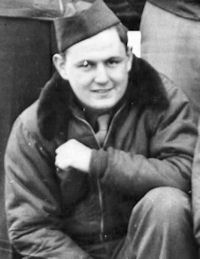 |
By September 1944, allied air power had strengthened its authority in the skies over Europe. Even so, Nazi war production persisted. Assigned to break the industrial back of the Wehrmacht were British and American bomber commands. The British, primarily flying Lancaster bombers, attacked targets by night, the Americans in B-24s and B-17s by day.
At dawn on September 28, 1944, sixty-three miles northeast of London, the sound of bombers thundered across the rolling hills of Molesworth, England. Thirty B-17Gs of the 303rd Bomb Group, Hell’s Angels, rolled along taxiways. Amid the deafening growl and clatter of radial engines, whirling propellers and the screech of brakes, ground crews paused in prophetic wonder.
Which crews would not return?
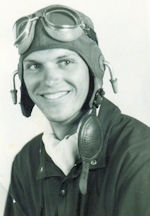 |
The train of Fortresses climbed through a thin cirrus cloud deck as Molesworth fell into a distant patchwork of hamlets and fields, the countryside a fairytale landscape.
Nelson felt the cold prop-wash in his face, the roar of engines a piercing din. Like a spectator in the bleachers at Chicago’s Wrigley Field, he watched scores of heavily laden planes circle, dip and weave, maneuvering to their assigned positions.
Aerial assembly could be as deadly as time over the target. Hundreds of bombers from scores of airfields across eastern England crowded the sky. Fog and gray overcast added to the perils. In radio silence, eyes squinted through the haze, straining for the sight of aircraft tail insignia as flares shot from lead bombers. Heads on a swivel, crewmembers watched for potential impact with other aircraft. A harried process; the 303rd would lose six bombers and crews to mid-air collisions before war’s end.
Relieved the morning had proceeded without mishap, Nelson crawled into the maw of the fuselage. He edged around the retracted tail wheel and arranged his parachute near the escape hatch. In cumbersome flight gear, he shoehorned himself into the tail section. Behind twin .50 caliber machine guns, Nelson adjusted his flak apron, attached the electric, oxygen supply and interphone lines to his flight gear.
 Gano’s crew cleared the coastline and settled into a position among 445 bombers of the 8th Air Force. The awesome armada, ascending beyond 15,000 feet, spread for miles across the late September sky. Below, waves rolled across the gray-green surface of the English Channel.
Gano’s crew cleared the coastline and settled into a position among 445 bombers of the 8th Air Force. The awesome armada, ascending beyond 15,000 feet, spread for miles across the late September sky. Below, waves rolled across the gray-green surface of the English Channel.
Nelson maintained a restless vigil, tested by the omnipresent mixture of fuel, exhaust fumes and constant vibration of the airframe. Always alert, he watched the position of other aircraft, listening for alterations to the steady drum of Buzz Blonde’s engines. A sudden change in pitch, an abrupt ascent or descent of the aircraft could mean trouble.
Over Ludwigshafen, Stuttgart, Mainz, and on other missions, trouble came in the form of flak, and German fighters, ruthless in their hunt for allied bombers. On occasion, a stricken B-17 attacked at high altitude fell upon another in a lower formation, or, a stick of bombs tumbled onto a Fortress that strayed from its assigned position. To a nineteen-year-old from Illinois it was an adventure tempered with danger and death in the skies over Europe.
Over the Channel, all crews were on oxygen. Frequent interphone checks ensured everyone remained alive and alert. Orders came to check guns. Nelson shot a burst, the twin .50s good to go.
Clearing the Dutch coast, Bombers of the 303rd droned on, their course set for the Krupp Grusonwerke and rail yards at Magdeburg.
In a freezing slipstream, twelve B-17s of Gano’s squadron ascended to 27,100 feet. Contrails streaked across a blue, limitless sky, wind howled through the aircraft as temperatures dropped to forty-degrees below zero and more.
At their posts, a bitter cold gripped the crew clad in bulky flight suits, insulated boots, gloves and flak aprons. Undaunted, they hunkered behind guns, flight controls, bombing and radio equipment. Every man in every bomber scanned the skies — Germany dead ahead.
Over Hallendorf, 250 miles from the Dutch boarder, the bomb group turned southeast. Deadly, black plumes: fields of flak burst across the sky. Most vulnerable to the lethal explosions was Group-C at 25,600feet. When the flak subsided a more deadly threat climbed through the lower cumulus.
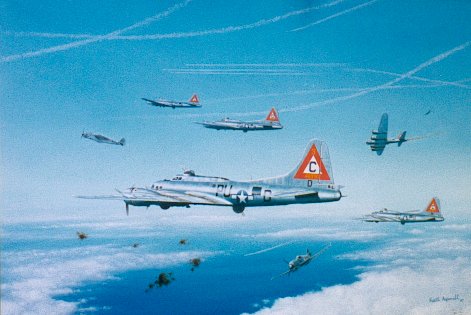
Death Over Magdeburg
by Keith Aspinall
Forty Focke-Wulf 190s and Messerschmitt 109 fighters blitzed the bombers at five and seven-o’clock. Like mad hornets, the fighters swarmed through the Fortress formations at over 350 mph. 20 mm cannon and 7.92 mm rounds punched through the bomber’s skin as if it were papier-mâché. Nine of twelve B-17Gs from Group-C fell in the first pass, one each from Group-A and Group-B would follow.
From the tail of Buzz Blonde, Ed Nelson witnessed the fighters, four or more abreast, tear through the lower formations. As if watching a tragic slow motion newsreel, wounded B-17s plummeted through space like massive un-tethered kites.
Across from Gano’s position, 1st Lieutenant Charles Glasgow piloted bomber 44-8335. Glasgow, on his first mission, took hits in two engines. Fire erupted in the radio room and the plane exploded.
Five sections of the aircraft, giant pieces of smoldering aluminum, trailed down through the sky.
Blown from the plane, Glasgow became the sole survivor.
Then the 109s hurtled toward Buzz Blonde, bullets tore through the bomber.
“Bandits, five-o-clock!”
“One at three!”
A deafening chatter of .50 caliber guns resounded throughout the B-17. In the ball turret, Sergeant Coyle opened up with twin .50s. Sergeant Burkemer operated the waist guns. Anthony, the flight engineer, had the .50s in the upper turret. Lieutenant Blessing, the bombardier, operated the nose guns.
Fighters scissored through the formation. A 109 winged toward Buzz Blonde. Nelson, in the most vulnerable position, fired a fusillade from the tail section.
“One at nine o’clock,” a voice cracked over the interphone.
A fury of bursts from Burkemer’s waist gun ripped into the Messerschmitt. The fighter rolled, nearly rammed the bomber then plunged earthward. Burkemer could have hit him with his gun barrel.
In the frenzy, Lt. Gano and co-pilot Wesley Flanders held their course.
As quickly as the fighters appeared, they vanished. In the freezing altitude, the drum of the bomber’s engines accompanied an anxious expectation. Again, deadly bursts of flak dotted the sky.
From the turn at the initial point to arrival on target was often an agonizing twenty minutes. Through fighters and flak the routine was a grueling experience. As the number of missions mounted, a grim crapshoot took hold in the minds of flyers. Which of the crews would not survive?
Nelson watched the bursts of flak chase toward the back of the plane. Whump! Whump! Whump! The third explosion beyond the canopy cast a menacing red glow at its center.
Buzz Blonde shook and rattled, buffeted by the blast concussions. A pebble-like sound rippled along the aircraft’s skin, shards of flak raining against the fuselage. All you could do was sweat it out.
On final approach, Lt. Blessing sat anxiously at the bombsite. A burst of flak tore into Buzz Blonde’s belly and number two engine. Metal shards ripped through the navigation and radio sections and severed the main air supply. Flight Officer Maniscalco blown to the deck disorientated but alive, his maps tossed into disarray. Stunned, the crew struggled to stay in the air—to stay alive.
Pressed into service, portable oxygen canisters provided air to breathe.
Shouts for help resonated through the interphone.
“Oh God, I’m hit!” yelled Corporal Meixner, the radio operator.
Sergeant Anthony shouted over the interphone that Burkemer, too, was down.
Coyle called out from the ball turret. “My eyes, I can’t see!”
Magdeburg could wait. Gano feathered the number two engine and ordered the bombs jettisoned.
From five miles high, two-and-a-half tons of ordnance rained down through the sky. “Bombs away,” Blessing announced over the interphone.
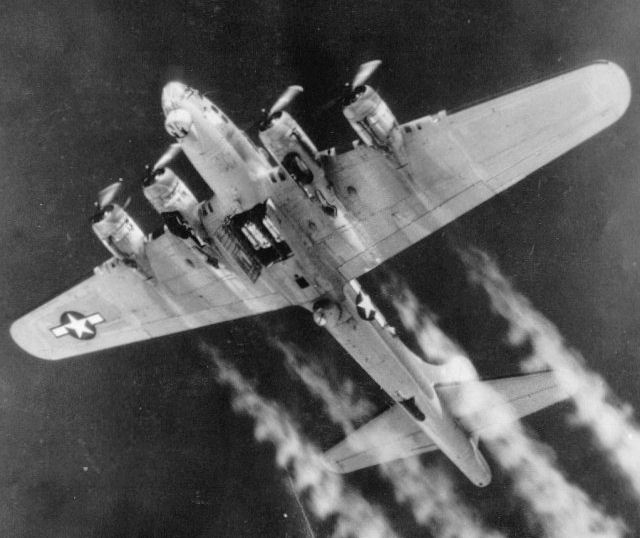
B17-G Bomb Run at Altitude
“Bombs away,” Blessing announced...
Buzz Blonde ascended, relieved of her lethal payload. Then Gano put the B-17 into a shallow dive. Descending from the protection of its formation, freezing wind howled through bullet and flak riddled fuselage. Ed Nelson, ordered forward, squirmed into the waist gunner’s section. Heart pounding, breathing labored, he stopped, shaken at what he saw.
Burkemer clung to his machine gun. A foot blown away, blood smeared the floor of the gun station. Anthony tore a first aid kit from the fuselage, bolts and all. Blessing burst into the compartment to help. Berkemer collapsed in shock. Coyle emerged from the damaged ball turret, out of the fight, hands held to his face, an eye embedded with shards of Plexiglas.
“Check Meixner!” shouted Anthony.
Nelson moved past the wounded and climbed into the radio room. Meixner lay on the floor grimacing with pain, a piece of flak lodged in his leg. Nelson quickly applied a tourniquet, warmed a morphine ampoule in his mouth then administered an injection.
Sedated, and immobilized with blankets, the wounded radio operator remained semi-conscious but alive. The cold altitude helped to check loss of blood. Nelson’s decision to leave the metal in place saved Meixner from bleeding to death.
Gano and Flanders maintained their controlled descent, managing the controls to compensate for the drag on the feathered port side engine. At about 10,000 feet, they leveled out and the crew could breathe unassisted. Far below, villages appeared on the landscape.
In their lumbering, nearly defenseless bomber, a dismal reality befell the crew. They were southwest of Berlin alone, and for the moment, lost.
Undaunted, Anthony, Blessing and Nelson tended to the wounded. Maniscalco, the navigator, reassemble his maps, plotted a location and course around major cities and flak emplacements. Gano set a westerly heading, fate resting in the twenty-two-year-old pilot’s skill, a compass heading, a determination to endure and a broken B-17.
The long miles slogged by against the steady drum of the cyclone engines. Gano and Flanders maneuvered their plane from one cloud formation to another, concealment their means of survival. A constant howl of freezing wind streamed through the battered fuselage, the crew sat gripped in apprehension. Shark-like, the Luftwaffe would come for the kill.
Nelson moved back to his guns and checked his chute and escape hatch. A rush of anxiety coursed through him. He had never bailed out before. Only one chance to get it right. Clear the plane. Check altitude. Pull the ripcord. Don’t forget my shoes. Can’t run in flight boots...
Then, fast approaching out of the northeast flashed the glint of two aircraft.
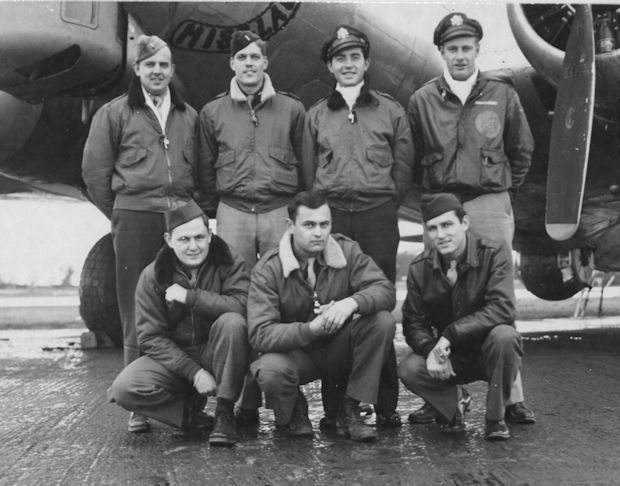
Gano’s Crew (14 Oct. 1944)
2nd Lt. Wesley Flanders, 2nd Lt. Fredrick Gano, F/O Jon Maniscalco, 2nd Lt. Gerald Blessing
Sgt. Edward Nelson, Sgt. George Anthony, Sgt. Arthur Coyal
Missing are Sgt. Berkermer and Cpl. Meixner, wounded on the Magdeburg Mission
Seconds mounted, Nelson and Anthony checked their guns. The pursuers closed on Gano’s crew. Nelson’s grip tightened on the twin .50s.
A voice called out, “They’re ours!”
Two Spitfires, each with British insignia, winged in on either side of the disabled bomber.
However, knowing that fighter pilots yearned to be aces, Nelson wondered if Buzz Blonde had just become the bait. Another scan of the horizon dispelled his unease; the skies were clear of predators.
Near the Dutch coast, Gano gave the Spits the thumbs up. The British fighters pealed away and Gano and co-pilot Flanders nursed the shattered bomber toward the Channel. Under a white cloud laden sky, England beckoned across the waves.
On approach to Molesworth, three flares shot from the beleaguered B-17, wounded aboard. Exhausted, Gano and Flanders muscled their rattled wreck to the runway. Without brakes, Gano rolled the bomber perilously close to the marsh at the end of the runway. At the last moment, he hit the right rubber peddle. At the end of a whirling 360 ground loop, the big B-17 came to a halt.
Medics rushed to the aircraft, Burkemer, Coyle and Meixner taken to hospital.
The ground crew counted 540 holes in Buzz Blonde and carted her off to the bone yard. She had sustained her last mission, twirled her last ground loop, and brought her crew home.
Gano’s crew had endured while the plight of others remained in question. In the hours of debriefing, and in the weeks that followed there arose accounts of heroic sacrifice, of desperate men caught in fateful struggles for survival, and of men who would never return from the mission to Magdeburg.
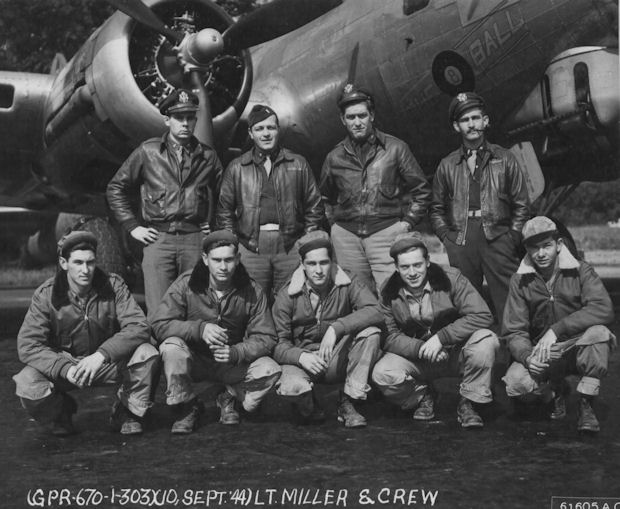
Miller's Crew (10 Sept. 1944)
2nd Lt. Arthur Conn Jr., 1st Lt. Teddy Smith, 2nd Lt. John Hill Jr. 2nd Lt. William F. Miller
Sgt. Leo Waldron, Sgt. Anthony Zelinio, Sgt. Warren Ball, Cpl. Max Smoler, Cpl. Johnny Huston
The crew of Miss Umbriago, was piloted by 2nd Lt. William Miller. In a hail of cannon fire, burning fuel streamed from ruptured fuel tanks. Radio Operator Frank Posada was blown into the sky and killed.
Tail Gunner Calvin Turkington, died on the floor of the plane while Engineer Leo Waldron and Gunner Tony Zelinio survived their parachute drop near a German farmhouse. In a village jail, both men spent an hour together. Then Zelinio, taken to hospital with leg wounds, never saw his friend again.
Dragged off and murdered by farmers, revenge had sealed the fate of Leo Waldron. An equally tragic end befell Navigator Arthur Conn Jr. and Bombardier Teddy Smith.
Only Lt. Miller, Co-pilot John D. Hill and Tony Zelinio survived to become POWs.
Acknowledged to have shot down Miss Umbriago is Hauptman Horst Haase. Flight Leader of IV Squadron, Jagdeschwader 3, Haase is credited with fifty-six aerial kills. On November 26, 1944, he collided with his wingman on a scramble take-off and died.
In another B-17, 2nd Lt. Glenn Gillespie went in a steep dive, fire streaming from two engines, the ball turret demolished. Gillespie’s bomber crashed south of Wolfenbuttel, Germany—no survivors.
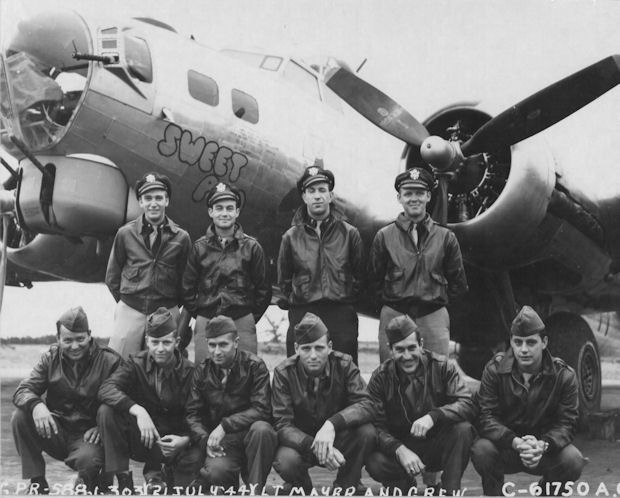
Mayer's Crew (21 July 1944)
2Lt Raymond B. Gradle (CP), 2Lt Oron J. Rogers (B), 1Lt Walter J. Mayer (P), 2Lt Jackson Hunt (N)
Sgt Harold E. Blessing (WG), T/Sgt Douglas E. Hicks (E), S/Sgt Ernest J. Gendron (TG),
T/Sgt Ernest Tuescher (R), Sgt James M. Campbell (BTG), S/Sgt Frederick J. Withers (WG)
For the crew of Bouncing Betty, flown by 1st Lt. Walter Mayer, a withering hail of gunfire hit Betty in all four engines. In a dive from 25,000 feet, Engineer Douglas Hicks struggled manually to close the bomb bay doors, and died when he jumped. It was his twenty-first mission. Lieutenant Mayer and the remainder of the crew survived their jumps, rescued near advancing allied lines
Engulfed in flames, The Silver Fox, piloted by 1st Lt. William Lay, 358th Bomb Squadron, flipped on its back and fell from 25,000 feet. Co-pilot David A. Grenier, severely wounded, motioned Sergeant Ray Miller to bail out. Miller refused to go without his co-pilot. Pushed from the aircraft in a parachute, Grenier disappeared amidst exploding debris. Ray Miller fell 10,000 feet, opened his chute and became the lone survivor of the Silver Fox.
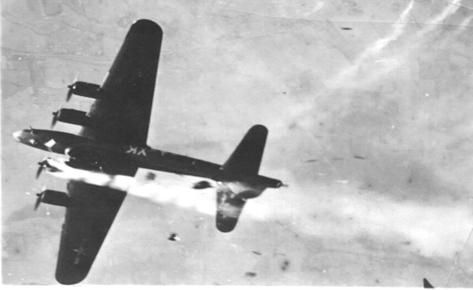 German fighters tore into 1st Lt. Charles Railing’s bomber. Its right wing on fire, the B-17 and crew fell from sight and crashed near Homburg, Germany. There were no survivors.
German fighters tore into 1st Lt. Charles Railing’s bomber. Its right wing on fire, the B-17 and crew fell from sight and crashed near Homburg, Germany. There were no survivors.
On his nineteenth mission with the 360th Bomb Squadron, 1st Lt. Arthur D. Michaelis piloted Flak Hak. Its right wing also on fire, Flak Hak spun into the ground from 25,000 feet. Captured near Gosler, Germany, Waist Gunner George Hlavac survived, while Lt. Michaelis and seven others perished.
Flaps down and nose up, a Focke-Wulf 190 fired its 20mm cannon into 1st Lt. Victor L. Howard’s B-17G. On fire, parts of the aircraft flew into the sky. In a spin, the B-17 descended from 20,000 feet.
Twenty-three-year-old radio operator, Sheppard Kerman, wounded, delayed his exit to aid Bombardier Jack Timmins to safety. In his parachute, Kerman drifted over Wolfenbuttel, Germany. He landed at Krumme Strasse #28, the chute draped onto the roof of the Crown Prince Hotel.
 |
Hauptman Welhelm Kanschack pulled Kerman through a window. Hands raised in surrender, Sheppard Kerman was shot dead.
At a 1946 war crimes trial, Kanschack received the death sentence, his two accomplices given life terms. Lt. Timmons remained forever grateful to Kerman who had stayed behind to save his life.
A formation of FW-190s pummeled the B-17G of 1st Lt. James T. Hahn, Magdeburg his 29th mission. The plane spiraled down from 25,000 feet, fire roared across the right wing. Hahn ordered a bailout when the plane exploded. S/Sgt’s Dabowski, Howard and 1st Lt. Benford died in the aircraft.
Radio Operator John Conkling and Waist Gunner Robert Proctor, parachutes riddled with 20mm shell fragments, plunged to their deaths. Navigator Charles Olson, Co-pilot James Fulks and Engineer Pete Kalasky survived, interred as POWs.
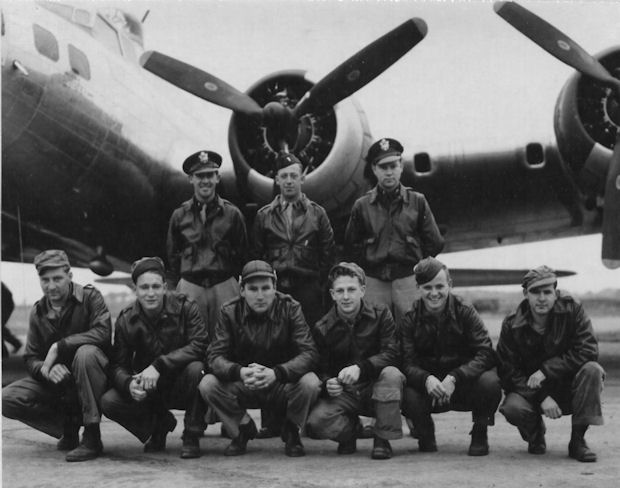
Hahn's Crew (23 June 1944)
1st Lt. James Hahn, 2nd Lt. Benton Woodbury, 2nd Lt. James Fulks,
Sgt Robert Lusk, Sgt Winifred E. Lemonds,
S/Sgt Leslie Traver, S/Sgt Andrew Darbowski, T/Sgt John Conkling, T/Sgt Pete Kalasky
(Sgt Robert Proctor, not picture, replaced Lemonds on 28 Sept. 1944)
Incredibly, Hahn managed to parachute from the torch-like wreckage of his bomber. He landed near Halchter, Germany. Taken into custody by Police Sergeant Wilhelm Bock, Hahn was marched to a rock quarry along with an unidentified flyer. Bock executed the flyer and shot Hahn in the chest.
By a miracle, Hahn remained alive, treated for the wound by a Red Cross nurse in a nearby town. Bock soon arrived with pistol drawn, ordered the nurse away and shot James Hahn in the head.
On April 3, 1947, following a trial for war crimes, Bock hung for Lt. Hahn’s murder.
2nd Lt. John Matheson piloted Minnie the Moocher, flying in the low bomb group. A barrage of cannon fire ripped through the plane killing Matheson, his co-pilot, engineer, and ball turret gunner. Minnie hurtled toward earth. Navigator Charles Gould, Bombardier Lorin Hamann, Radio Operator Leo Jeambey and Waist Gunner William Fredenburg bailed out at 18,000 feet. Surviving the tragic deaths of their crewmates, the four became prisoners of war.
Attacked by German fighters, 2nd Lieutenant Edward F. Schields, Jr. was last seen strapped into the seat of his B-17G. The ill-fated fortress corkscrewed down through the battle-strewn sky, men trapped by the force of the centrifugal spin. Navigator Bruce Stangohr desperately struggled to open the escape hatch, while Bombardier Wilber Lee crawled through the blown out nose cone.
When the plane exploded, only Lee and Flight Engineer Leland Nagle survived.
On the mission to Magdeburg, eleven bomb crews, one-third of the 303rd, did not come back. A ghostly pallor hung over the Bomb Group’s barracks, beds of ninety-nine men lost in action sat vacant. In the weighted stillness, among those who did survive, quiet whispers of an all too recurrent refrain filled their thoughts. “There but for the grace of God—”
However, there was little time to dwell on the fallen. In the morning, there would be another mission and others after that until war’s end.
“We had a job to do,” said Nelson with calm reflection. “You simply had to push some things aside and carry on.”
“I lost some friends, fellow pilots, on those missions,” said Fred Gano in the slow western cadence of his speech. “It was a long time ago.” His voice trailed off.
Except for Sergeant Burkemer, who would loose part of his leg, and Meixner, who would fly no more, Nelson, Coyle and the rest of Gano’s crew would go on flying B-17s.
By the close of World War II, the 303rd Bomb Group lost 210 aircraft and 841 of the 25,000 USAAF personnel killed in the European Theater of Operations. Over 55,000 valiant RAF flyers died. Equally dreadful are the deaths of hundreds of thousands of civilians attributed to the tragedy of both Axis and Allied bombings. In an arrogant act of cowardice, Adolf Hitler, architect of this calamity, put a bullet in his head in a Berlin bunker. A week later, Allied nations declared victory in Europe, May 8, 1945.
Decades later, a clandestine back-story to World War II came to unfold. Magdeburg would provide the scene for the concluding mystery—hidden Nazi bodies.
 Following the war, the city fell within the Russian zone of control. Russian archival evidence demonstrates that upon occupying Berlin, Soviet military counter intelligence, SMERSH, gained possession of the remains of Adolf Hitler, Eva Braun, the Gobbels family and Army Chief of
Staff, General Hans Krebs. Numerous secret internments and forensic exhumations preceded final burial in a courtyard plot of the Soviet military barracks at Magdeburg.
Following the war, the city fell within the Russian zone of control. Russian archival evidence demonstrates that upon occupying Berlin, Soviet military counter intelligence, SMERSH, gained possession of the remains of Adolf Hitler, Eva Braun, the Gobbels family and Army Chief of
Staff, General Hans Krebs. Numerous secret internments and forensic exhumations preceded final burial in a courtyard plot of the Soviet military barracks at Magdeburg.
On April 4, 1970, Yuri Andropov, then head of the KGB, ordered the obliteration of what remained of the bodies. In the darkness of April 5, 1970, the cremated and pulverized remains vanished beneath the brown, swirling waters of an Elbe River tributary—a final yet covert closure to World War II.
Ed Nelson survived thirty-five combat missions over Europe. Awarded the Air Medal with five oak clusters, the European Theater of Operations Medal with one star, and European Air Medal with one star, Ed put the war behind him in 1946. He earned an engineering degree and worked in the machine industry for forty-seven years. In their 80’s, Ed and Betty Nelson spent their retirement years with their family between Orland Park, Illinois and Bonita Springs, Florida. Sadly, Betty passed away in August 2010.
Fredrick Gano received the Air Medal with five oak leaf clusters, the European Theater of Operations Medal and European Air Medal with service stars for action in France, Germany and the Ardennes. Discharged at Fort Douglas, Utah in 1945, Fred went on to earn commercial and instructor ratings and flew for the U.S. Forest Service. Later he became chief pilot in de Havilland Herons for Air Idaho. He was married for fifty-eight years to Katherine Grohosky Gano until her death in 1999. They have five children. At ninety, Fred lives with his daughter, Katharine and her husband in Boise, Idaho.
Ed Nelson and Fred Gano are two of the many anonymous heroes to which this nation owes its undying gratitude—among the last Hell’s Angels.
Author: Mr. Rogers is a U.S. Air Force and thirty year police veteran who lives and writes from Bonita Springs, Florida. (Bibliography available upon request.)
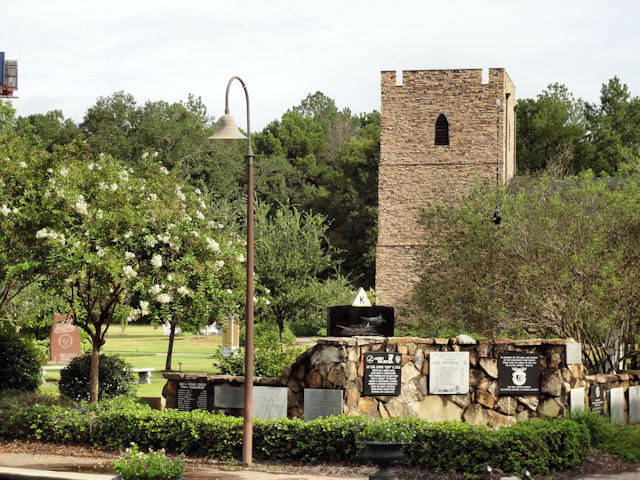
Remembered at Memorial Service
By Gary L. Moncur
It was in the beautiful Memorial Gardens of the Mighty Eighth Air Force Museum in Pooler, Georgia where Susan and I first met Harry Gobrecht. The date was August 19, 1998. We said a final good-bye to him and his sweetheart in the same beautiful Memorial Gardens on September 4, 2011.
Harry passed away on August 10, 2010. Barbara, his bride of 62 years, joined him on April 18, 2011. Both of their lives were celebrated in a touching memorial service. The service was attended by numerous family members and friends, including the Moncurs, Dick and Marjorie Johnson and Keith and Peggy Ferris.
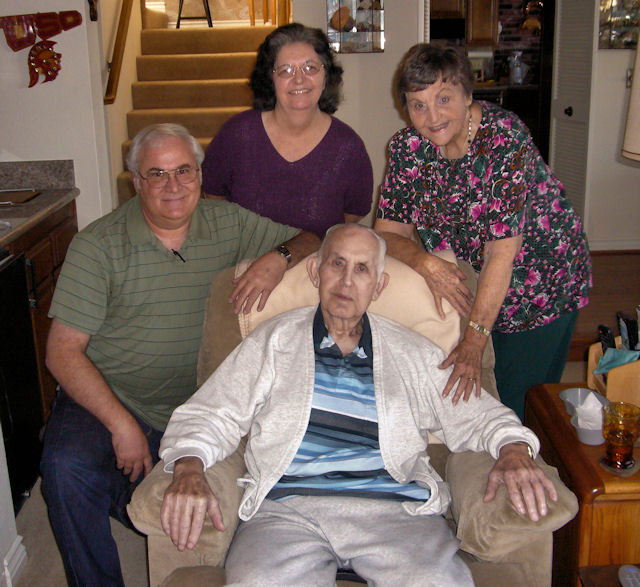
The Gobrechts and the Moncurs in December 2006.
Harry and I had a near father/son friendship from our first meeting on the telephone during 1997. We worked very closely together as the website, www.303rdBG.com, was being developed. We emailed and talked on the phone daily for over seven years. Our bond grew closer and closer as the years went on. In 2004 his health began to fail. Our contact continued, but it was more about families and friends and less about the WWII history. He and Barbara were very proud of their children and grandchildren. My last phone call to Harry was during the July 2010 Eighth Air Force Reunion in Tucson. He was unable to speak, so I relayed our love through his dear Barbara.
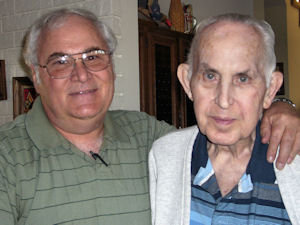 Harry Gobrecht was, without question, the most knowledgeable person on earth regarding the 303rd Bomb Group. His book "Might in Flight" is a historical masterpiece. Working with him so closely was a graduate-level history lesson for me. His contribution to keeping the legacy of the 303rd Bomb Group alive places him in a group with very few peers.
Harry Gobrecht was, without question, the most knowledgeable person on earth regarding the 303rd Bomb Group. His book "Might in Flight" is a historical masterpiece. Working with him so closely was a graduate-level history lesson for me. His contribution to keeping the legacy of the 303rd Bomb Group alive places him in a group with very few peers.
It was Harry who sent me information to add to the website on an almost daily basis. It was Harry that answered most of my questions about the 303rd Bomb Group. Now, I answer those same questions for 303rd Bomb Group family members and friends. It was Harry who helped me understand what my own father had gone through in the war and how it had shaped his life. It was Harry who taught me to love and respect my father even more. It was Harry who taught me to embrace the remarkable history of the 303rd Bomb Group and to love the men who made it.
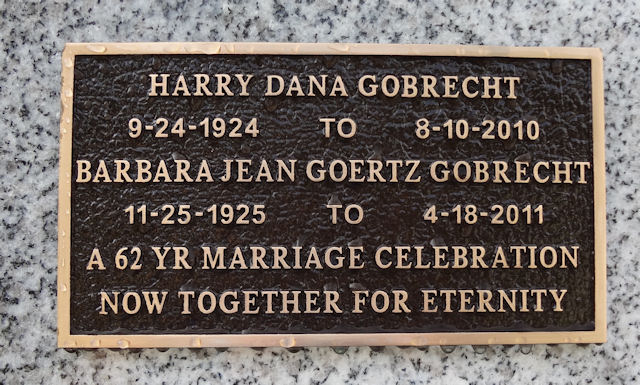
by Ella Wheeler Wilcox
There are two kinds of people on earth today;
Just two kinds of people, no more, I say.
Not the sinner and saint, for it's well understood,
The good are half bad, and the bad are half good.
Not the rich and the poor, for to rate a man's wealth,
You must first know the state of his conscience and health.
Not the humble and proud, for in life's little span,
Who puts on vain airs, is not counted a man.
Not the happy and sad, for the swift flying years
Bring each man his laughter and each man his tears.
No; the two kinds of people on earth I mean,
Are the people who lift, and the people who lean.
Harry was a lifter. He was my mentor. He was my confidant and friend. It was my privilege to have known him. — Rest in peace, "Helpful Harry." I'll see you when my work here is through.
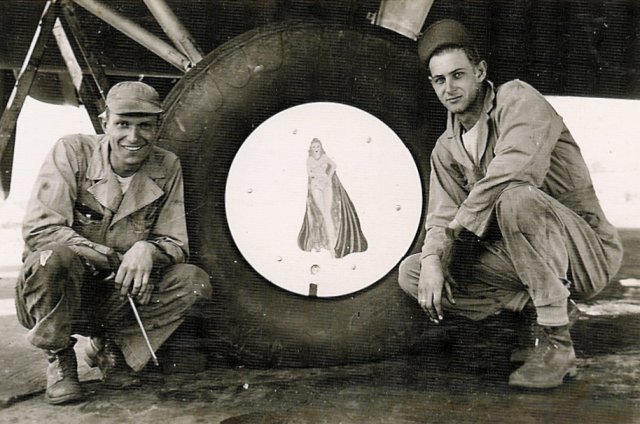
Wheel Art on B-17G #42-31483 Bonnie 'B' (359BS) BN-P
Can you identify these men? The Crew Chief was Bill Zachar.

 SEE YOU THERE !!
SEE YOU THERE !!8th AIR FORCE HISTORICAL SOCIETY ANNUAL REUNION SHERATON WESTPORT – LAKESIDE CHALET ST. LOUIS, MO – OCTOBER 11 – 16, 2011 Reunion and registration information are now available. See: http://www.8thafhs.org/reunions.htm |
Ehle Reber Municipal Airport to be Dedicated in October
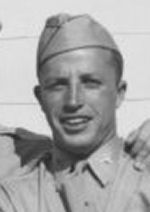 Malin, Oregon city councilman Stan Pence opened the June 17th issue of the Herald and News to a bit of a surprise. The featured story on the front page was about an almost forgotten local hero, 1st Lt. Ehle Reber, and his last combat mission as a B-17 pilot over Nazi occupied Europe. Like so many of the original World War II B-17 crews, Reber and his crew lost their lives on their final mission. It was their seventh.
Malin, Oregon city councilman Stan Pence opened the June 17th issue of the Herald and News to a bit of a surprise. The featured story on the front page was about an almost forgotten local hero, 1st Lt. Ehle Reber, and his last combat mission as a B-17 pilot over Nazi occupied Europe. Like so many of the original World War II B-17 crews, Reber and his crew lost their lives on their final mission. It was their seventh.
Pence had lived in Malin for many years but had never heard of Ehle Reber. Driven to learn more, he began to ask community members what they recalled of Reber. Most knew little more than that his name was one of the many listed on the Veteran's Memorial at the end of Main Street. City recorder Kay Neumeyer put Pence in touch with Ryan Bartholomew, President of the Malin Historical Society. Pence called Bartholomew and got the break he was looking for. Among the historical society's archives were numerous personal belongings of Reber including an extensive biography.
Bartholomew and Pence agreed to meet for dinner so Pence could learn more about this local hero. Bartholomew explained that Reber was "the one every young man looked up to, the one they wanted to be like," an outstanding citizen and athlete at the high school and collegiate level. After their one hour dinner Pence came up with an idea. The Malin Municipal Airport was currently under renovation. He decided it would be a fitting tribute to rename the refurbished airport in honor of Reber.
At the July Malin City Council meeting, Pence brought the motion before the other council members. Mayor Zieg recognized Councilman Pence and gave him the floor. After proposing the name change, Councilman Pence read the following biography of Reber:
EHLE HIRAM REBER
JANUARY 30, 1920 - JANUARY 23, 1943
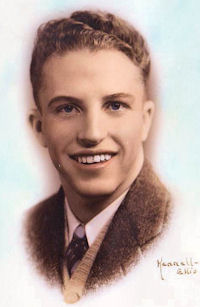 Although his years on this earth were few, Ehle H. Reber was a hero to many. Malin High's Student Body President, Captain and quarterback of the football team, all-star basketball player, state champion broad jumper and shortstop for the Klamath Falls Junior Legion baseball team, Reber was known throughout the region as an outstanding citizen and athlete. Proving he was more than a "Big fish" in a small pond he excelled at the collegiate level serving as Captain of one of Bill Hayward's legendary University of Oregon track and field teams.
Although his years on this earth were few, Ehle H. Reber was a hero to many. Malin High's Student Body President, Captain and quarterback of the football team, all-star basketball player, state champion broad jumper and shortstop for the Klamath Falls Junior Legion baseball team, Reber was known throughout the region as an outstanding citizen and athlete. Proving he was more than a "Big fish" in a small pond he excelled at the collegiate level serving as Captain of one of Bill Hayward's legendary University of Oregon track and field teams.
Compelled to serve his country, Reber joined the Army Air Corps upon college graduation in 1941 becoming one of America's pre-Pearl Harbor boys. Stationed at Molesworth, England as a member of the 303rd Bomb Group, Reber piloted his B-17, the "Jerry Jinx" seeing combat action in the first air campaigns over Nazi occupied Europe.
Fully dedicated to the cause of freedom until his last breath, 1st Lt. Ehle Reber and his crew joined the great tragic cavalcade of young men "gone west" 23 January 1943 during their seventh mission over Lorient, France. The heartfelt speech brought emotions out of many in attendance; none of whom knew Reber personally. Pence's motion was quickly seconded and the vote to rename the Malin Airport in honor of Reber was unanimous.
A dedication ceremony is tentatively scheduled for early October once the airport refurbish is complete. An unveiling of a plaque honoring Reber, speeches, an F-15 flyover and dinner are scheduled events for the day.
![]()
By HARVEY RICE, HOUSTON CHRONICLE
Saturday, August 20, 2011
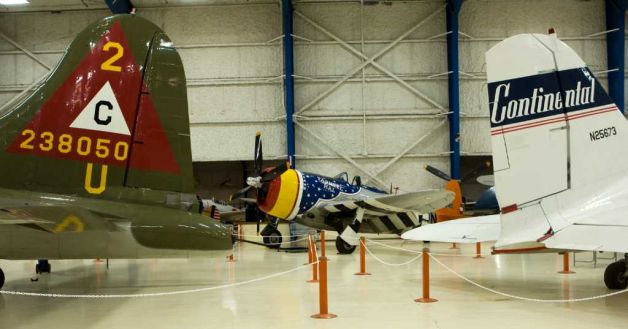
GALVESTON - Hurricane Ike continues to take a toll in Galveston almost three years after striking the island city. The latest casualty is the Lone Star Flight Museum, a Galveston tourist attraction since 1990.
The storm did more than $18 million in damage to the museum, resulting in its relocation to Ellington International Airport.
"I can't risk another 8 feet of water being in the facility," said the museum's executive director, Larry Gregory.
The decision will cost Galveston an attraction that drew 50,000 visitors a year, but it will be part of what is shaping up to be a major aircraft exhibition center at Ellington. At the museum's new home, its 13 flying and six display aircraft will join a half-dozen Vietnam War-era aircraft owned by the Collings Foundation-Houston and a growing collection of vintage military aircraft owned by the Texas Flying Legends.
"The idea we've been kicking around is, the public buys one ticket for three museums," said Flying Legends President Chris Griffith. "We have the resources that can really turn Ellington Field into the war-bird capital of the South."
The new museum and hangar will be bigger, more modern and add a theater and a restaurant, Gregory said.
The Houston City Council last week approved a 40-year contract with the museum for 14 acres at Ellington, said Ian Wadsworth, chief commercial officer for the Houston Airport System. The contract commits the museum to making at least $7.5 million in improvements. The $15,000 annual rent is about the same it's paying at Scholes International Airport in Galveston, Gregory said.
The Airport System expects the museum to bring more visitors to the former military field. "We were very keen to welcome them to Ellington," Wadsworth said.
Construction should begin in about 18 months, according to Gregory, who estimated the move could take three years.
Galveston officials are unhappy but understanding about the museum's decision.
"Everyone wants the museum to stay, but we understand what they have to do," said Leah Cast, spokeswoman for the island's Convention and Visitors Bureau. "The most important thing for the flight museum, and everyone in Galveston, is that those aircraft are protected."
The 50,000 visitors the museum draws each year is tiny when compared to the 5 million tourists who visit the island annually, Cast said.
Tourists spend an average of $103 per day in Galveston, including about $14.25 on tickets, according to 2008 study by Angelou Economics. But many of the museum's visitors come first to see the adjacent Moody Gardens and the Schlitterbahn Galveston Island Indoor Waterpark, Cast said, so it's difficult to calculate the economic loss to the city.
Although the museum's prospects at Ellington are bright, the decision to leave Galveston was bittersweet, Gregory said.
"Galveston is a big part of our history," the museum's director said. "You kind of hate to let them down."
Ike destroyed several small experimental aircraft and submerged some larger ones, including the museum's World War II Spitfire, in corrosive saltwater, Gregory said. Lost are irreplaceable memorabilia such as a rare document known as a blood chit carried by Flying Tiger ace David Lee "Tex" Hill over China as he battled the Japanese air force. Blood chits ask civilians to assist downed pilots, but Hill's was written with Chinese characters printed on silk, Gregory said.
"We did save Tom Landry's football," he said, referring to the legendary former Dallas Cowboys coach. "Luckily it stayed inside the building and it floated around."
The cherished Spitfire, which gained fame in the Battle of Britain, was disassembled by a crew that is cleaning and checking every part in a process that will take as long as four years.
Hud Hopkins, airport manager at Scholes, said he immediately extended the museum's lease by 20 years after the storm, but that wasn't enough to keep it from moving. Hopkins and Gregory discussed making the museum storm-proof, but the cost was prohibitive.
The prospect of Lone Star's move caused the Collings Foundation - which boasts the only airworthy civilian-owned, Vietnam-era F-4 Phantom - to consider building a new museum as well, according to foundation spokesman Rick Harris. He said he was waiting to see what kind of contract Houston offered Lone Star before approaching the foundation's board of directors in Stow, Mass., about a new building.
"We are very excited about them coming up and we would like to do something similar," he said. The Collings Foundation display is open by appointment only, but Harris said he expects that policy to change.
Texas Flying Legends purchased a hangar at Ellington last October and already has a small museum. It intends to spend $3 million to build a new one for its six aircraft, including one of only two airworthy Japanese Zeros from World War II. Flying Legends will have spent more than $7 million by the time its new museum opens in about a year, Griffith said.
The Flying Legends aircraft are in Houston six months of the year, but the organization expects to increase its fleet enough to maintain a year-round display, he said.
Harris envisions a cluster of museums similar to those at Great Britain's Duxford Field, home to the Imperial War Museum and several private aircraft collections.
3rd ANNUAL WEBSITE and NEWSLETTER FUND DRIVE
![]() Our sincere thanks goes to those who supported the annual fund drive last month and those of you who contributed previously. Your help takes the financial worries out of keeping this history free and available to the world. If you would still like to help with this effort, your contributions are always appreciated..
Our sincere thanks goes to those who supported the annual fund drive last month and those of you who contributed previously. Your help takes the financial worries out of keeping this history free and available to the world. If you would still like to help with this effort, your contributions are always appreciated..
![]()
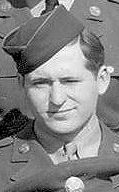 Edward Swierczynski of Harrison, MI passed away on September 15, 2011 after a brief illness. Born June 1, 1922 in Nanticoke, PA.
Edward Swierczynski of Harrison, MI passed away on September 15, 2011 after a brief illness. Born June 1, 1922 in Nanticoke, PA.
He was employed by the Civilian Conservation Corps (CCC) as a youth and served in the Eighth Air Force 303rd Bombardment Group "Hells Angels" during World War II serving 2 1/2 years in the European Theater as a Corporal.
He retired to Harrison in 1981 from Avis Industrial Corporation/Melling Forging Co., after 35 years of service. He was preceded in death by his parents, son-in-law, Bruce E. Reeder, 1 brother and his wife of nearly 50 years, Betty Mae (Earley) Swierczynski. Surviving are his daughter, Suzanne J. Reeder; 4 grandchildren, Jeffrey A. (Beverly) Reeder, Lisa A. (Ethan) Grant, Christina L. (Ronald) Riggs and Christopher D. (Kelly) Reeder; 8 great-grandchildren; 3 step great-grandchildren; 1 great-great-granddaughter; 1 step great-great-grandson; and very special friend, Mary Shaw; 3 brothers, Fred Swierczynski, Stan (Dorothy) Swierczynski, and John (Irene) Swierczynski; 3 sisters, Mary Haskell, Helen Hudson, and Sophie Estee.
Funeral services will be held at 2:00 P.M. on Tuesday, September 20, 2011 at Gorsline Runciman Funeral Home, 900 E. Michigan Ave., Lansing. The family will receive friends Monday, September 19, 2011 from 6:00 P.M.-8:00 P.M. at the funeral home. Interment will be held at Evergreen Cemetery, Lansing. In lieu of flowers those desiring may make contributions to the American Heart Association , Memorials and Tributes Lockbox, 3816 Payshpere Circle, Chicago, IL 60674. On line condolences may be made at www.grlansing.com
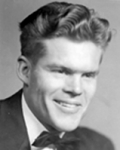 Heber "Dean" Hansen, known as Dean to family and friends; loving husband, father, brother, grandfather, and great-grandfather, passed away on Saturday, September 10, 2011 in Salt Lake City. Born November 9, 1921 to Heber Lorenzo and Myrtle Jane (Simmons) Hansen in Burley (Pella), Idaho, was the eldest son of eight (sister, Joy being 1 year older).
Heber "Dean" Hansen, known as Dean to family and friends; loving husband, father, brother, grandfather, and great-grandfather, passed away on Saturday, September 10, 2011 in Salt Lake City. Born November 9, 1921 to Heber Lorenzo and Myrtle Jane (Simmons) Hansen in Burley (Pella), Idaho, was the eldest son of eight (sister, Joy being 1 year older).
After completing courses at the LDS Business College in Salt Lake City, Dean enlisted in the army June 1940, eventually becoming a First Lieutenant in the Army Air Corps, serving as Navigator on a B-17 with the 358th Squadron, 303rd Bombardment Group (Hell's Angels) stationed in England. He was shot down 30 Mar 1945 near the German border, becoming a POW for about 3 months in Stalag-Luft #1.
The next year he went to Brigham Young University to study Geology while holding down three jobs. He met his eternal companion, Barbara Joyce Treu, when he was up on the "Y" mountain white-washing the "Y" (Barbara was not supposed to be up there, but ventured up there with her cousin Mary Nell!). Dean fell fast and hard for her and, shortly thereafter, they "eloped" (with Barbara's mother, Erma, in tow) to Elko, Nevada, where they were married by an LDS Bishop on May 18, 1948. In Oct 1952, their marriage was solemnized in the Salt Lake Temple with the four oldest children present. After graduation from BYU, Dean and Barbara moved to the Los Angeles area where Barbara had been born and grew up. Dean started off working for Barbara's uncles (Jackson Brothers General Contractors), and subsequently, went to work for Industrial Asphalt. He became the proud father to seven sons and one daughter.
Dean served as a Rotarian and was well-liked and respected in the community. He served as a Bishop and Stake President in The Church of Jesus Christ of Latter-day Saints. He worked in construction and in the asphalt business, eventually managing the Sealcoat division of Industrial Asphalt in Los Angeles, CA. He and Barbara went into Real Estate for several years in the San Fernando Valley, with Dean gaining his Broker's license with Century 21. In 1996, Dean and Barbara moved to Ridgefield, WA near their daughter and a few sons, where they lived until 2003. Dean drove bus at Portland International Airport during that time. In June 2003, along with Barbara's 99-year-old mother, Erma Treu, they moved to West Jordan, UT to live near Barbara's brother and sister-in-law, Bill and Vicki Treu. Erma passed away in October of that year and Barbara, subsequently, passed away in 2006.
In 2007, Dean reconnected with his high school sweetheart, Afton (Christensen) Cook, courted, and married her later that summer. He is survived by his wife, Afton; sister: Joy Hansen Staples; brothers: Harold (Clarice), Glenn (Marilyn), and Jim (Lynne) Hansen. He is also survived by his children: Doug (Penny); Mike; Linda (Mike) Taylor; R. Scott; Randy (Lisa); Rick (Robin); and Rob (Babette); 30 Grandchildren and 17 Great-Grandchildren along with many beloved nieces and nephews.
Preceded in death by wife: Barbara Joyce (Treu) Hansen; son: Steven Harold (Gayle) Hansen; parents: Heber Lorenzo Myrtle Jane (Simmons) Hansen; brother: Max John Hansen; sisters: Mary Deline (Hansen) Reed; and Anna Marie Hansen (infant).
Services will be held on Friday, September 23, 2011, at the Utah Veteran's Cemetery, 17111 Redwood Road, Bluffdale, Utah. Being held in the Camp Williams Chapel, the viewing will be at 10:00 a.m, the funeral services at 11:00 a.m., with burial immediately following.
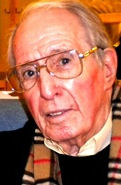 Harold Joseph Bach, D.D.S., age 87, died peacefully September 9, 2011.
Loving husband of Frances for 66 years. Father of Christina (Chato Hill), Jonathan, and the late Richard Bach.
Brother of Gertrude Bach and the late Earl and June. Wonderful, adored grandfather of Nicolas and Elizabeth Hill, and Peter, Alex and Joseph Bach; and great-grandfather of Mason and Elliot Hill.
Harold Joseph Bach, D.D.S., age 87, died peacefully September 9, 2011.
Loving husband of Frances for 66 years. Father of Christina (Chato Hill), Jonathan, and the late Richard Bach.
Brother of Gertrude Bach and the late Earl and June. Wonderful, adored grandfather of Nicolas and Elizabeth Hill, and Peter, Alex and Joseph Bach; and great-grandfather of Mason and Elliot Hill.
Hal was the kindest, most gracious and caring soul, a superb and beloved dentist in Detroit and Birmingham, and a revered Little League baseball coach. In WW II Hal flew over 30 missions as a co-pilot in the 303rd Bomber Group.
Memorial Service Wednesday, September 14 - 10:30 AM at White Chapel Cemetery (Chapel of the Psalms), 621 W. Long Lake Road, Troy. Visitation begins at 9:30 AM. In lieu of flowers contributions to
Alzheimer's Association, 20300 Civic Center Drive, Suite 100, Southfield, MI 48076 -or- U of D Mercy Dental School, 4001 W. McNichols, 4th Floor Fisher, Detroit, MI 48221 are welcome.
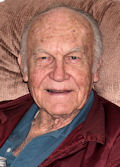 Theodore Ralph "Buddy" Beiser, a native and lifelong resident of Fairhope, AL, died Thursday, August 25, 2011. He was 90 years old.
Theodore Ralph "Buddy" Beiser, a native and lifelong resident of Fairhope, AL, died Thursday, August 25, 2011. He was 90 years old.
Buddy was born in Fairhope on February 23, 1921 and was the youngest child of Felix and Rosa Beiser. He grew up in the family home, Englewood Villa, which is now the campus of First Baptist Church. He is preceded in death by his parents, his wife, Marita Brueggemann Beiser, and his siblings Elsa "Ricki" Redditt, Carl William Beiser, Dorothy "Mama Dot" Cain, Helen E. Hunter, and Elizabeth Zadnichek. He was a graduate of the Marietta Johnson School of Organic Education.
He is survived by his daughter Melanie Jean Beiser of Fairhope, his son Paul (Carolyn) Beiser and grandchildren Alison Vivienne Beiser and Kevin Theodore Beiser of Fort Collins, CO, and many other family and friends.
Buddy was an avid outdoorsman and loved to fish in Mobile Bay, hunt, and play golf. He helped found the City of Fairhope’s Quail Creek Golf course and played golf there for many years. In 2005, the Alabama Department of Conservation and Natural Resources named the T.R. Buddy Beiser Reef, an Alabama Inshore Fishing Reef near Montrose, in his honor. He was a lifetime active member of the Fairhope Yacht Club. He was among the many courageous young men who served in WWII. Lt Theodore R. Beiser was a B-17 bomber pilot with the 427th Bomb Squadron, 303rd Bomber Group (Hell’s Angels), Eighth Air Force, Army Air Corps stationed in Molesworth, England. He flew 37 successful bombing missions during the war and also served as a pilot instructor and was awarded the Distinguished Flying Cross with Oakleaf Cluster and Airforce Medal with 3 Oakleaf Clusters. After the war, Buddy worked in Fairhope, at Brookley Air Force Base, and as a quality control inspector for NASA in Florida during the height of the race to the moon. Mr. Beiser will be remembered as a kind and honorable man, a wonderful father, a good friend, and a happy person who loved his family and the outdoors. He will be greatly missed.
Donations in Mr. Beiser’s name can be made to the Alabama Wildlife Federation for Restoration of the Buddy Beiser Fishing Reef. His family would like to thank the staff and the wonderful caregivers at Fairhope Health and Rehabilitation for their support and kindness.
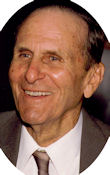 Richard Elayer McAllister was born June 3, 1922 at the Peachtree Farm outside Piedmont, Wayne County, Mo. to Stephen Pinkney and Alice (Elayer) McAllister. He died June 13, 2011 at Hillcrest Care Center in Wray.
Richard Elayer McAllister was born June 3, 1922 at the Peachtree Farm outside Piedmont, Wayne County, Mo. to Stephen Pinkney and Alice (Elayer) McAllister. He died June 13, 2011 at Hillcrest Care Center in Wray.
He was the younger brother of Lois Elizabeth and Donald Stephen and the older brother of Alice Nell. He attended Patterson High School and entered the U.S. Army Reserve in 1940 and joined the Army Air Corps in February 1942.
Richard was involved in the Air Offensive European Campaigns as a medic for the 303rd Bomb Group, 359 Medical Group. For this service he was awarded the Bronze Star.
He was discharged in 1945 and headed to St. Louis, where his sister Lois Payne and her family lived. He worked in that area for several months when he and a good buddy from childhood, Shorty Tinker, decided they’d head to the mountains of Colorado where a dam was being built near the town of Granby. The job was great and well-paying, but the real “pay-off” was meeting a little redhead who was a waitress at Circle H Corral Restaurant and Bar right above the valley where the construction work was taking place.
Just under two months after meeting Marilynn, they were married Oct. 7, 1946 in St. Louis with his sister Lois and her husband Jim Payne standing up with them.
Richard loved construction work and this meant a “few” moves for the newlyweds—Patterson, Mo., Stanton, Mo., Paris, Mo. and then a move to Stanton, N.D. where he worked on the Garrison Dam for a year and where their daughter Janet was born in 1948.
Richard was preceded in death by his parents; brother, Don; sisters, Lois and Nell; brothers-in-law, Jim Payne and Monte Brooks; half-brother, Bill McAllister; and his beloved wife, Marilynn.
Richard is survived by his daughter, Janet and husband Jerry of Wray; son, Terry McAllister and wife Cara of Burns, Wyo. and Richard James McAllister of Sterling; grandchildren, Jami Gornault and husband Nick of Springfield, Mass., Stacey Besse and husband Derrick of Cheyenne, Wyo., Jessica McAllister and fiance Kyle Baldwin of Cheyenne, Mary McAllister of Laramie, Wyo., Zachary McAllister of Wray, Toby Graham and wife Courtney of Sterling, Marty Graham and wife Leela of Philadelphia, Pa. and Melanie Godsey and husband Chad of Stillwater, Okla.; great-grandchildren, Grace and Sullivan Graham of Sterling, Madison and Grady Godsey of Stillwater, Lily Graham of Philadelphia, Kaden Baldwin of Cheyenne and Taryn Renee Besse of Cheyenne; and many nephews and nieces.
Cremation was requested. Memorial services were held June 17 at Wray United Methodist Church with Rev. Norman Stott officiating.
![]()
Gary,
My father-in-law, Harvie Collins, who is now home with his Lord, was an original crew member of Snap! Crackle! Pop! Recently I found an aviation artist near my home town of Buffalo, MN who does flight jacket art on the back of leather jackets. I decided to have him put the nose art from dad's plane on my jacket. As you will notice from the attached picture, he did a great job!
He also does paintings of planes, squadron patches and more!
His name is
Jim Ouellette
418 Edelweiss Lane NW
Saint Michael, MN 55376
(763) 497-2812
I thought you might like to have this information in case anyone else in the 303rd family wants to carry on the legacy of a beloved family member like I do!Highland Goodman
Gary,
I can't tell you how heartwarming it is to read the stories of my father's comrades-in-arms, and see the tributes from folks all over the world in honor of the men who flew the skies over Germany in WWII. My father, Philip Peed, was shot down in while flying over Schweinfurt in Joan of Arc, and was a POW from Oct. 14, 1943 until the war ended. I was recently cleaning up some things after moving he and Mom from their home to an independent living facility, and was both delighted and amazed to come across all of his letters written to his folks while in Stalag Luft III, as well as newspaper clippings saved by his family and telegrams to his folks from the war department detailing his transition from MIA to POW to liberation. He has written of his experiences and I am currently editing them, and will forward some short items to you for consideration for possible publication in your amazing newsletter. Thank you so much for all you have done to keep the memories of their heroism and sacrifice alive.John Peed
The daughter of Charles Palmer and niece of Joseph Palmer thanks you greatly for your sharing the story. Her name is Adele Bavani and I am her cousin, Donnie Berardino. I forwarded the email to her.
God Bless our soldiers.
DonnieMy name is George A. Parrish, veteran of the 91st Bomb Group 1943-1944, 401st Squadron. I flew a tour of 31 missions, credited with 35 missions from November 1943 to September 1944. I was a member of the John D Davis crew as Flight Engineer/ Gunner.
I am on your E-Mail list to receive the Molesworth Pilot, for this I thank you for your newsworthy letter. Everything you print is most interesting for me and I am sure for all your members from your 303rd Group. I wish to commend you for the most interesting stories and happenings relative to your Group members. I am a member of the E-Mail Ring of the 91st Bomb Group with lots of joy to read the mail that Mike Banta sends via the e-mail service, as well as the Newsletter "The Ragged Irregular" with four mailings each year. Please continue the messages to my E-Mail address.
Sincerely, George Parrish
Gary,
Sgt Robert L. Stevenson (KIA) / T/Sgt James F. Shelly (KIA) Last year in April you ran a story about the Martin Plocher Crew. I have finally scanned some of Albert C. Steele Jr's photos from his WW II 303rd Bomb Group scrapbook. My dad was a crew member of S for Sugar & Old Crow. His best friend was Robert L. Stevenson of Frost, Texas who was KIA from the Martin Plocher Crew. My brother Steven was named in his memory. Attached you will find a photo of R L Stevenson. I wasn't sure if you had a photo of him or not since one was not in the article.
Also attached is a photo of T/Sgt. James F. Shelly who I also believe was KIA, (not on the same mission). I'm hoping you will place it on the website. My father would have been pleased that their memory has been preserved so that no one can forget them.
I have more collages and crew photos to come. You have my permission to publish any or all of these in the newsletter.
Jeri
I was really surprised to see my father’s picture [Chappie Slawson] submitted by the Fitterer family! The obit for Mr. Fitterer did not specify his duties with the 303rd. He was the chaplains assistant for Father Skoner and he stated in a letter to me some years ago that my father’s assistant was a young man named Fisher and that they shared duties between them as needed. He stated that he was very close to my father, which would account for the personalized picture. In his letter to me he recounted an amusing incident. If you will give me an address I will send you a copy of the letter that you can edit/excerpt as you see fit for inclusion in the “Pilot”.
The other picture “athletic exhibition” includes my father, top row far left. He was involved in wrestling and suffered a rib injury at some point that caused a few problems over the years.
Also, I am sure you probably keep tabs on LSFM activities and may already have heard that they are relocating the museum facilities to Ellington Field secondary to the recent hurricane disaster. Probably a 3+ year project. Article was in the Sunday August 21, 2011 Houston Chronicle. Previous consideration had been given to moving up to Conroe but I guess that is not to be. That would have been real close to me so I am disappointed about that! It would have been nice to have “Thunderbird” nearby and likely flying over the house on occasion...
Jack Slawson
Keeping the Legacy Alive,

|
